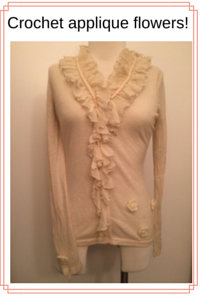Hi, there!
 Thanksgiving is tomorrow, and I wanted to begin by giving thanks for being able to connect with you every two weeks with “our” newsletter. I have been having so much fun with the topics and I know it’s not one-sided because of all the e-mails I receive with glowing comments and solutions and questions about all things fashion. I am really thankful for the family this newsletter has developed into, one in which members share their knowledge and assist each other in looking their best.
Thanksgiving is tomorrow, and I wanted to begin by giving thanks for being able to connect with you every two weeks with “our” newsletter. I have been having so much fun with the topics and I know it’s not one-sided because of all the e-mails I receive with glowing comments and solutions and questions about all things fashion. I am really thankful for the family this newsletter has developed into, one in which members share their knowledge and assist each other in looking their best.
Happy Thanksgiving to all!
This week I’m going to be answering Alice’s third and final question, and I am super excited about it.
Question #3:
If a stain becomes permanent, what can we do with the piece of clothing? If it’s not prominent and can be hidden, is it okay to keep wearing it?
I’m going to break Alice’s question down into 2 parts.
Part 1: If a stain becomes permanent, what can we do with the piece of clothing?
This is such a great question! I hear it a lot from my clients. It’s a fun one to answer because it brings out the designer side of me!
If you’re like me you like to have items that are unique only to you. What girl or guy doesn’t want to be unique? Of course the downside to that is the price we have to pay for a one of a kind can get to be pretty expensive. So, if you like to bring out your inner designer and play with your creativity, you’re going to love this one.
Quite a few years ago, I bought a beautiful ivory Tahari cashmere cardigan sweater that really played to the “Charming Femme” side of my personality. I loved this cardigan and wore it dressed up and down over lacy camis.
Unfortunately, the moths got to my sweater and put several holes in it. Like Alice stated in her e-mail to me, I too was devastated over what I thought was a loss of a favorite item.
Tossing it out was something I didn’t want to do, and wearing it with holes was a definite no-no. So I put on my creative hat and began to brainstorm on what I could do to solve this little dilemma. It was then that I had an “aha!” moment.
I used a needle and thread to sew up the holes. It was a sweater knit and I didn’t want the fine yarns to unravel. Therefore, I inserted the needle into any “loops of yarn” very carefully, to prevent any further unravelling and opening of the holes. Don’t worry if you’re not a good darner. You don’t need to be extremely neat about this because the sewn holes won’t be visible at all.
So if your favorite item is not ruined by moth holes, but has a small stain or a few small stains. This solution will work just as well for that problem also.
Now, before I go on, I realize that you probably don’t have bags and bags of trims like I do. You won’t need to sweat it – sorry couldn’t resist the pun. I’m going to share with you a few resources that you can use to help you find the perfect thing to cover up the holes or stains on one of your favorite items, so keep reading.
I went into my bags and bags of trims from my designer days and found the perfect mohair crochet flowers (1 1/4” in diameter) that just happened to be in an ivory color to match my sweater.
However, if you have no fun trims in your sewing box that you can use for your damaged garment, grab your blouse/sweater, or whatever is damaged, and head down to your local fabric store. Jo-Ann Fabric and Craft Store is a chain store. It’s not the best nor does it have the most variety but you may find the perfect little gem there to cover up your stain.
If Jo-Ann’s doesn’t have what you need, or if you want to find something that is even more interesting and unique, head to a specialty fabric store. My favorite is Britex in Union Square, San Francisco. It is the ultimate in fabrics and trims. But be warned, it can be a little overwhelming and you could spend hours there, (not to mention lots of money!) like a kid in a candy store! I hear Piedmont Fabrics in Oakland is a find but I haven’t been there yet, so if you go, let me know what you think.
If you have a favorite garment stop for nicknacks, by all means, go and check them out. And do let us all know. You can post your favorite place in the comments section directly on my blog at http://michellemoquin.com/comments-suggestions-questions-4/, or you can email me and I’ll include it in a following newsletter with your permission.
What you want to do is look for trims (buttons, appliques, lace, embroideries, patches, even fabric, etc.) that are large enough to cover the stain or hole completely. How you design it is up to you.

- We want the overall look to be as if it were part of the original design as possible. So make sure that the trims you are considering don’t clash with the garment.
- Look for textured trims that are the same color as the garment like I did with the crochet flowers. Or add pops of color to a neutral garment, or add a neutral trim to a colored garment.
- Don’t just cover the hole or stain with one piece of trim. This will look too obvious as if you’re covering something up. (Which you are but nobody needs to know!) Use a few pieces of trim and scatter them on the garment in a design. It doesn’t need to be symmetrical – that can look contrived. Sometimes something abstract works just as beautiful too. Work with odd numbers such as 3 or 5 pieces of trim.
- Have fun with this! You don’t need to stick with one type of trim or one color. For instance if you have a hole on a black and white stipe cashmere sweater, find some pretty sequin florals in black or white in one design or similar designs, or find different styles in different colors, or different styles in the same color.
- Guy’s, you’re going to be more limited in your choices, but it is not impossible. Plaid patches can be very classic or avant-garde depending on how they are used. Interesting plaid patches can make a once dressier solid or stripe shirt made to wear with suit, be a perfect weekend shirt with jeans if done in a simple and creative way.
- Once you have found your perfect trim(s) to cover your hole or stain, and have created a pretty pattern out of one or a few different trims, and they are laid out on the actual garment, look at the overall garment and see if you like it. If you do, you are done, and ready to purchase your trims. Note: Adding trims may change how you clean this garment so speak to a salesperson first about the best way to clean your garment with the added trims. Do this before you purchase them.
- If you want to have more fun, recreate the same pattern on another part of the garment or just add a few more pieces of trim scattered on other parts of the garment to tie it all in. Besides adding Mohair flowers to the hem of the sweater to cover the holes, I also added them to one sleeve cuff. How much or how little you add to your garment or, how many different varieties of trims you use, is strictly up to you and your creativity.
- However if this is your first time doing this, don’t get stuck in all the possibilities – because there will be many! Try to have some fun and play with your creativity, but keep it simple. Remember, this garment is something that you once loved “as is.” You don’t want to put so many different things on it that you now have a challenging time pairing it up with items in your closet. Remember one of the charms of this garment was the easy way it worked with the rest of your closet. I want you to be able to wear it again – not have it be such a masterpiece that it doesn’t work with anything, creating another frustration!
- If the damage is from holes and not stains, don’t forget to sew up the holes first before you add your trims. If the holes are too big and will create pulling or gathering, you don’t need to stitch up the holes so that they disappear, you only need to stitch them up loosely so that they don’t get bigger. Your trims should be big enough to cover the holes or stains completely.
- Add your trims on by hand-sewing or machine. If you’re machine sewing them on, you most likely will not need to hand stitch up your holes at all because the machine stitches will secure the hole from opening up even further.
Now, sometimes a stain, hole or rip cannot be dressed up with trims, be can easily be cut away. If you have ever gotten your pant hem or long coat stuck in the car door and it has created a stain or a hole, that is too big to cover up without making it look like a “patch” job, sometimes the easiest way to solve the damage is to shorten your garment.
Ladies, if you wore a particular pair of pants with heels, you can shorten them to now wear with flats. Long full skirts can also be shortened, as well as tops or coats that have been frayed or ripped near the hem.
Gentleman, there isn’t much you can do if it your pants have been severely ripped. However, if it is a high quality suit, cashmere coat, or a pair of slacks, that has a small hole anywhere on the garment, and you don’t want to say goodbye to it, the only thing you can do is have the fabric re-woven by a re-weaver, as long as the hole isn’t too big. This is not an inexpensive process but the results are so good that you won’t even know that you once had a hole there. And it is totally worth it. Without A Trace is a reputable place to have this done. If you have the extra yarns from the garment that needs to be rewoven, make sure that you send it along with the item.
Part II: If it’s not prominent and can be hidden, is it okay to keep wearing it?
In my professional opinion, even if the stain or hole is not prominent and can be hidden, I wouldn’t wear the garment, and I suggest that you don’t either, unless you dress it up as I have described above.
Think about it this way. It is no different than wearing holes in your undergarments. You are the only one who knows it is there, but what if it was revealed to someone else? It could be quite embarrassing, not to mention the style message it would be sending.
There’s a reason why lingerie for women, and undergarments for men, come in lots of colors and interesting fabrics and styles. There is something wonderful that happens to our confidence when we know that we are wearing something special even if it is just for our own pleasure.
So even if you have a hole or a stain that no one else can see, you know it is there. My suggestion is that you still follow the above tips and find something pretty or whimsical or interesting to cover it up that makes you smile when you think of it, even though no one else may ever see it.
And…if someone else does see it, you will most certainly make them smile in surprise because of your effort, sending quite a different message. And no doubt you will be smiling too. My guess is, you’ll want someone to accidentally see it. Now that is fun fashion at its best!
That’s it for this week. If you end up using my tips to dress up your stained or holed garment and are just delighted with the results, please e-mail me a photo. I would love to see what you did and share it in the coming newsletters and blogs with your permission, of course!
Now, it’s your turn. I’d love to hear from you. Your insights and inspiration are appreciated so please share your stories in the comments below.
Blog me.
Love and appreciation,
~Michelle


Hi Michelle!
I love this idea. I shop at a clothing store that sells seconds and many times they are damaged. This is a great solution to covering up those holes and stains. I’m looking forward to buying some trims, bringing out my ‘inner designer’, and having some fun! Thanks!
xo,
Aretha
Hi, Aretha,
What a great idea to apply this solution to seconds or even damaged designer goods. I may have to use my advice for that as well! Thanks so much for sharing. Have fun with your “inner designer!” I’d love to see what you do!
Love,
~Michelle